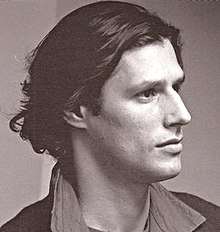Bruno Fonseca
Bruno Fonseca | |
|---|---|
 Bruno Fonseca, 1989 (from "Bruno Fonseca: The Secret Life of Painting") | |
| Born | 1958 New York City, US |
| Died | May 31, 1994 (aged 35–36) |
| Known for | Painting, Sculpture |
| Notable work | The War Murals |
| Movement | Abstract, figurative |
| Parent |
|
| Relatives | Caio Fonseca (brother) Isabel Fonseca (sister) |
Bruno Fonseca (1958 – May 31, 1994) was an American artist who shifted between abstract and figurative styles and worked in both painting and sculpture.[1]
Biography[edit]
Early life[edit]
Fonseca was born in New York to a family of artists. His father, Gonzalo Fonseca, was an Uruguayan sculptor. His younger brother Caio Fonseca is a well known contemporary painter. His sister Isabel Fonseca is a writer. Fonseca had dyslexia and a stutter, conditions so severe as a child he was treated by a psychiatrist.[2][3] Fonseca was able to compensate for his verbal difficulties with a tremendous visual fluency, reproducing paintings by Michelangelo and other Great Masters at an early age.[2] Raised in a house on West Eleventh Street in Greenwich Village, Fonseca studied at the Dalton School in Manhattan and St. Ann's School in Brooklyn Heights. Fonseca failed to graduate from high school[4] and at age 18, he moved to Barcelona, where he studied with Augusto Torres. Fonseca lived in Barcelona until 1993, when he returned to New York a few months before his death.
Fonseca had what his sister called "a slightly perverse anti-taste for exquisite goods and 'luxuries' of all kinds."[2] He preferred old objects, old clothes and junk that he collected from the streets of Barcelona. He chose to live in Barcelona's red-light district, among the city's poor, cripples, addicts, street girls, and bohemians.[5]
Career[edit]
Late in his life, Fonseca painted four large paintings known as "The War Murals" depicting scenes of warfare. The individual works are titled Tank (oil on canvas, 208.2 x 269.2 cm) Fire (oil on canvas, 207 x 284.5 cm), Bucharest (oil on canvas, 208.2 x 279.4 cm), and Timișoara[6] (oil on canvas, 210.8 x 271.7 cm). One writer described the anti-war theme in "The War Murals", begun in 1989 and finished in 1993, as "the most powerful statement of their kind since Picasso's great Guernica."[7] The murals were inspired by images of boy soldiers torn from the newspaper and by images of violence in Eastern Europe, including the public execution of Nicolae Ceauşescu.[2][8] His sister recalled watching scenes of the upheavals in Eastern Europe on CNN with Bruno and wrote: "The War Murals - Bruno's four larger narrative paintings inspired by the anti-communist upheavals - represent his greatest synthesis of abstract and representational painting, something he had struggled for throughout his working life."[2] Fonseca worked on the murals for several years, finishing them while he was suffering from the effects of AIDS.[2] A public showing of "The War Murals" was the opening exhibition for the John McEnroe Gallery in SoHo in January 1994. Fonseca also had a solo show at New York's Salander-O'Reilly in 1993.[9][10]
After contracting AIDS, Fonseca returned to New York. He married his pupil, German painter Anke Blaue, shortly before his death. He died of AIDS in 1994 at age 36.[1]
Notes[edit]
- ^ a b "Bruno Fonseca, 36, Painter and Sculptor". The New York Times. 1994-06-03.
- ^ a b c d e f Isabel Fonseca (2000-11-04). "Dear Brother". The Guardian.
- ^ "A Remembrance of Bruno Fonseca". The Charlie Rose Show. 2000-11-23. Archived from the original on 2008-05-14.
- ^ Bruno Fonseca: The Secret Life of Painting, p. 21
- ^ Alan Jenkins; Karen Wilkin; Isabel Fonseca (2000). Bruno Fonseca: The Secret Life of Painting, pp. 7-9. Abbeville Press. ISBN 0-7892-0626-9.
- ^ Timișoara is the city where the anti-Ceauşescu revolution began in 1989.
- ^ Bruno Fonseca: The Secret Life of Painting, p. 198 "Together they constitute a remarkable work, the more remarkable (given the larger scale) in that the painter was, as he worked on them, already suffering from the illness that would kill him. ... I think them the most powerful statement of their kind since Picasso's great Guernica."
- ^ Bruno Fonseca: The Secret Life of Painting, pp. 191-204
- ^ Robert G. Edelman (February 1994). "Review of exhibitions: Bruno Fonseca". Art in America.
- ^ Gerrit Henry (December 1993). "Reviews: Bruno Fonseca". ARTnews.
- 1958 births
- 1994 deaths
- American contemporary painters
- 20th-century American painters
- American male painters
- People of the Romanian Revolution
- American war artists
- AIDS-related deaths in New York (state)
- People from East Hampton (town), New York
- American people of Uruguayan descent
- Artists from Manhattan
- People from Greenwich Village
- Dalton School alumni
- Saint Ann's School (Brooklyn) alumni
- Hispanic and Latino American artists
- 20th-century American male artists
